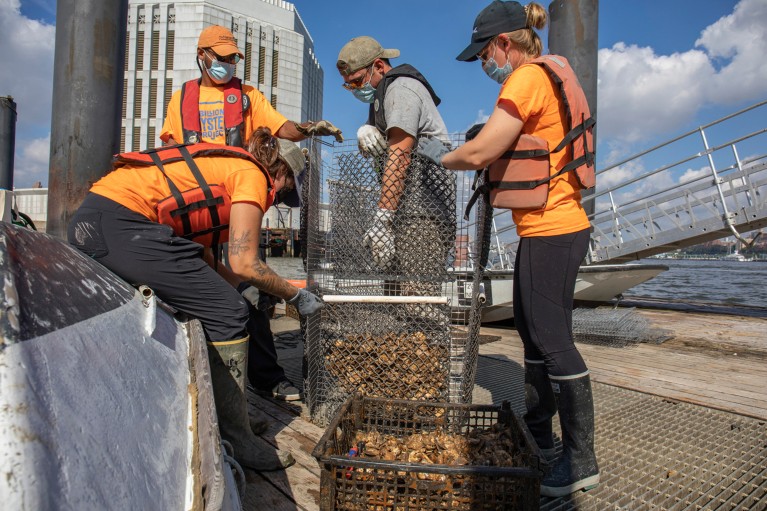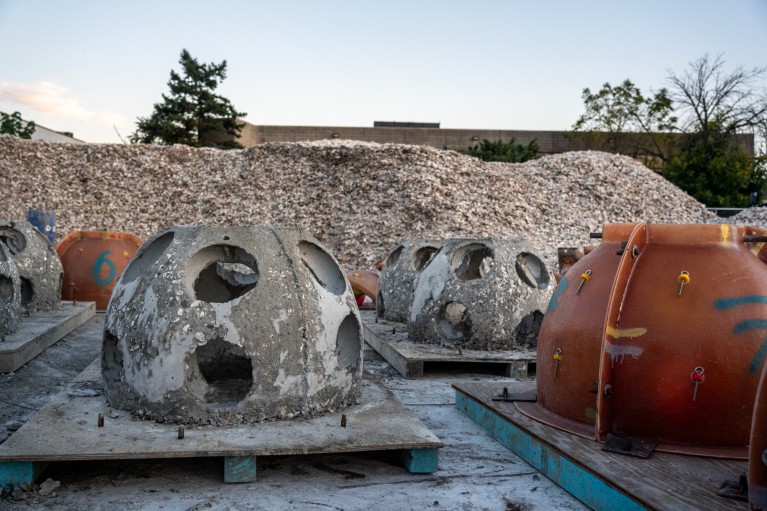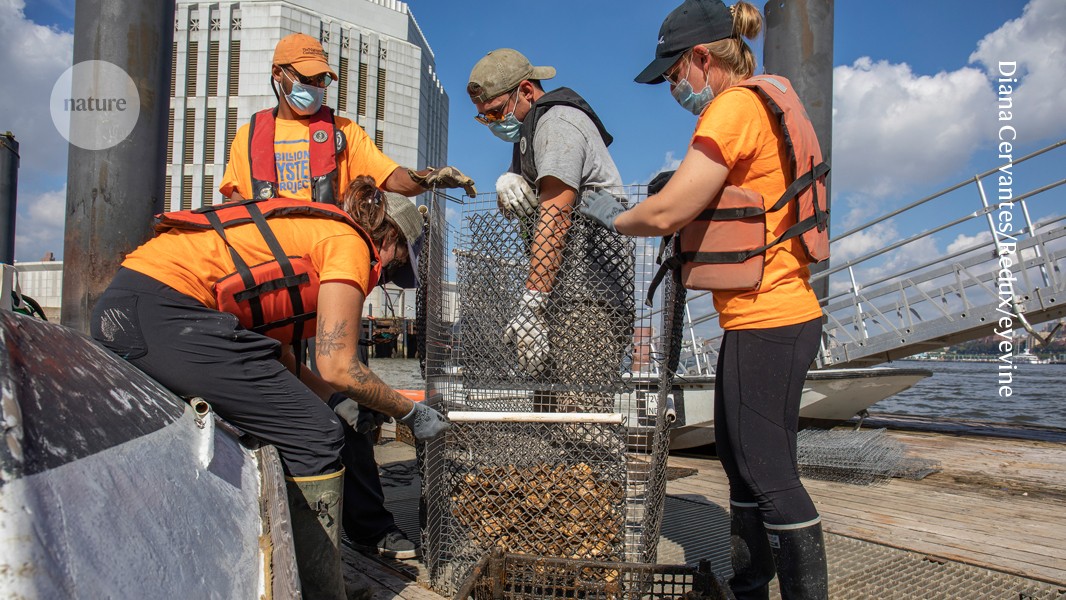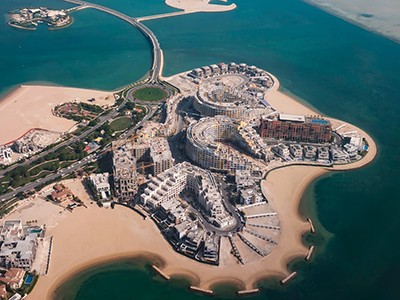
Workers for the Billion Oyster Project prepare to place juvenile oysters in a waterway running through New York City.Credit: Diana Cervantes/Redux/eyevine
New York City
As the Sun dropped behind the Statue of Liberty on Saturday, a staff member for a conservation group unlocked a gate on a nearby island to reveal the ingredients for a potential oyster renaissance: stacks of ‘reef balls’, large domes made of oyster shells and concrete. They will soon be placed in tanks filled with free-swimming oyster larvae. Once the larvae latch onto the balls and mature, the structures will be submerged in the murky waters off New York City in an effort to revive a lost ecosystem.
Coastlines around the globe were once protected by oyster reefs, expansive masses of oysters that had fused to rocks and each other. Overharvesting and habitat loss have demolished about 85% of Earth’s oyster reefs in the past two centuries. But bringing them back could help coastlines to become more resilient to the effects of climate change, including intense storms and erosion, scientists say.
Can floating homes make coastal communities resilient to climate risk?
The Billion Oyster Project, a non-profit organization in New York City, is leveraging the bivalve’s engineering skills to slowly build a living breakwater. After a decade of refining the process, the project is generating know-how for other efforts that it has inspired elsewhere.
“The foundations are there to rebuild these ecosystems, and there are considerable environmental and social benefits of doing this,” says Melanie Bishop, a marine ecologist at Macquarie University in Sydney, Australia. But it is still unknown1 whether restored reefs can grow large enough to buffer coastlines, and oyster-restoration proponents acknowledge that it will take an untold number of transplanted oysters and many years before reefs can provide a bulwark against rising seas.
Mass of molluscs
Centuries ago, New York Harbor, which lies between the five boroughs of the city — Manhattan, Staten Island, Brooklyn, the Bronx and Queens — and parts of New Jersey, was home to a massive conglomeration of eastern oysters (Crassostrea virginica) spanning nearly 900 square kilometres. Demand for the succulent molluscs skyrocketed as the city’s population boomed; at the same time, pollution in the harbour escalated, and by 1927, the oyster-reef ecosystem had collapsed.
The Billion Oyster Project seeds oyster beds at 18 sites around New York City. Its goal: to initiate the reef-building process. If the oysters can consistently reproduce on their own, they could one day form a structure that buffers against hurricanes and extreme storms while protecting the shoreline from eroding into the rising sea, says Asly Ventura, a public-outreach coordinator for the project. Studies have found that oyster reefs boost biodiversity2 and can improve water quality3, which could create safe havens for other species as ocean conditions change.
The larval molluscs need to settle onto hard, stable surfaces to grow. To provide a home for them, the project staff and volunteers mix crushed oyster shells, donated by restaurants, with recycled concrete, and use the slurry to make hollow, domed structures pocked with holes that are roughly one metre in diameter. Staff drop several of these domes at the project’s reef sites each summer, with the goal of forming vast shoals of oysters at each site.

Domed structures called reef balls are stored in New York City. They will be lowered into the nearby waters to provide a home for young oysters.Credit: Alix Soliman/Nature
The campaign has had mixed success. Of the 122 million oysters that were transplanted into the harbour by the end of last year, about half have died. “We do expect a large amount of die-off,” Ventura says. Oysters produce a lot of young because so many larvae die, she says. In 2022, the organization reported that oysters were naturally reproducing at about half of the installations.
Pollution could partially explain why the molluscs aren’t multiplying on their own at every site. After it rains, a combination of raw sewage and stormwater is piped into the harbour. Lingering industrial waste contributes to poor water quality. Noise pollution could also be interfering with the larvae’s ability to find a suitable place to settle, because they use auditory clues to locate existing reefs, Ventura says.
Ray Grizzle, a marine biologist at the University of New Hampshire in Durham, who has done scientific assessments for the project, says that juvenile oysters mostly settle within 400 metres of their parent reef. As a result, oysters might not self-seed readily at sites far from existing reefs.
Grizzle’s greatest concern is how pathogens, such as the parasites Haplosporidium nelsoni and Perkinsus marinus, might affect oysters over the long term. “They’re down to about a 3- to 5-year lifespan now, when historically it was probably 10 to 20,” he says. When the lifespan is reduced, so is the population’s ability to form lasting vertical reef structures, he says. All the same, the project is “moving in a good direction”, Grizzle says.
Reef resurgence
Other restoration projects are taking off around the world. In Australia, biologists attracted oysters simply by dropping limestone boulders onto a sandy sea bed. Larval flat oysters (Ostrea angasi) naturally settled on the rocks in densities that far exceeded expectations2, suggesting the larvae are travelling from unknown remnant reefs or oyster farms.
“We didn’t know we were going to get any natural recruitment when we started,” says study co-author Dominic McAfee, a marine biologist at the University of Adelaide in Australia. The effort is meant to sustain the seafood industry and has increased the biodiversity of invertebrates at the site.
In the North Sea, researchers are placing oyster larvae on the granite boulders at the base of wind turbines in an effort to fortify the structures and increase biodiversity.
Bishop says that for oyster-reef projects to be successful, they need to be located in areas where the issues that led to their demise are no longer present, constructed to withstand predicted changes to the ecosystem and monitored for much longer than two to three years. Although there is a long way to go, “there is a lot of hope”, she says.



